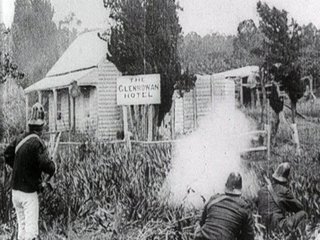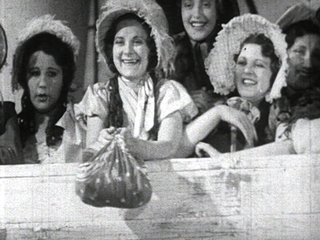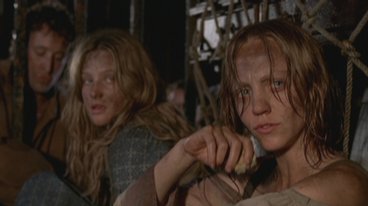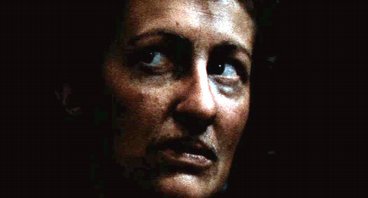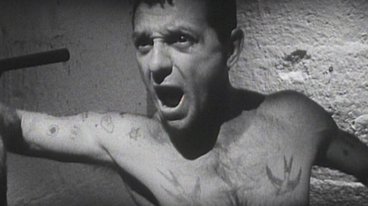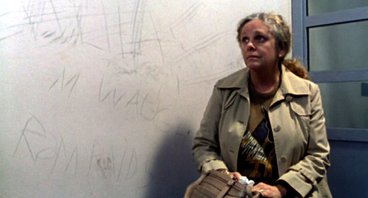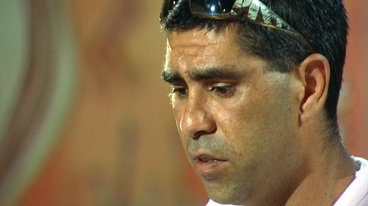Prisons on Film
I’ve been a prisoner at Port Macquarie
At Norfolk Island and Emu Plains
At Castle Hill and at cursed Toongabbie
At all these settlements I’ve been in chains
But of all places of condemnation
And penal stations in New South Wales
To Moreton Bay I have found no equal
Excessive tyranny each day prevails
‘Moreton Bay’ – Australian folk ballad
Jailbirds and bushrangers
Excessive tyranny does indeed prevail, especially in Australian penal cinema, but how could it be otherwise? Australia was founded as a series of convict settlements (unless you come from South Australia), so it could be argued that we have a special affinity for movies about prison, the big house, chokey, stir, a stretch, or whatever you like to call it. And with incarceration comes misery and cruelty, in excess.
Our foundation heroes on film were jailbirds and bushrangers, starting with Ned Kelly in 1906. The bushranger genre was so popular in Australia in the first decade of the 20th century that it was banned in two states, New South Wales and Victoria, because the police thought it was encouraging lawlessness.
The story of Ned Kelly was one of the first feature films made anywhere in the world, possibly the first. It ran six reels, which would make it about an hour long, although most of it is lost. We have only 18 minutes of footage, which includes the shootout at the Glenrowan Hotel, but not Ned’s actual hanging at Old Melbourne Gaol in 1880. It is hard to imagine that the filmmakers would not have depicted that as their dramatic finale, but we don’t know. If they did, it would have been among the first movie depictions of an Australian jail, although perhaps not the first.
The Salvation Army made a short enacted drama around 1898, depicting their ‘prison-gate brigade’ helping a man convicted of petty theft, on his release from prison. Now lost, this has a strong claim to be the first fiction film made in Australia, albeit lasting less than three minutes.
Convicts
After 1912, bushranging films disappeared for many years, although there was no prohibition on films about jail, transportation, capital punishment and other deterrents to bad behaviour. These were morally acceptable, because they took the fun out of crime. In 1913, Moondyne (directed by WJ Lincoln) told the story of a West Australian convict who escapes from sadistic treatment to live with a tribe of Aborigines. A surviving still from the film shows George Bryant, who played the convict, dressed in prison issue uniform, a shapeless jacket, cap and pants stamped with the hated symbol of the three-pointed arrow.
The broad arrow symbol was originally stamped on anything that was the property of the British government, but it was not used on convict uniforms in the earliest years of the Botany Bay colony, simply because there were no uniforms. It would have been fitting, because convicts were, in effect, owned by the British government. WJ Lincoln appears to have specialised in convict melodramas. In 1913 he also directed Transported, the story of an Englishman transported to Australia for trying to force the woman he loved to marry him. That film contained a scene with convicts breaking up rocks, wearing uniforms that look suspiciously like the ones from Moondyne. Both of those films are lost.
Silent Australian cinema was obsessed with crime and punishment, partly because melodrama was the most popular form of story. A large number of the films told of men who committed crimes in England, or were transported even if they didn’t commit the crime, and their reversal of fortune in Australia. Sometimes they got the girl, sometimes they got the farm, a few times they got a hangman’s noose, but only if they deserved it. Storytelling was still very much influenced by the reforming zeal of the churches, partly because the early silent cinema depended on successful plays for script material. Many of those were the kind of moralising English melodramas popular in the late 19th century.
One of the most loved Australian silent films was popular because it satirised that reforming zeal. In The Sentimental Bloke, directed by Raymond Longford in 1919, Bill the Bloke (played by Arthur Tauchert) tries to go straight after doing a stretch for ‘stoushing Johns’ – beating up police who raided the two-up game in which he was engaged. Bill the Bloke is one step ahead of jail for most of the film, trying hard to curb his appetites for drinking, gambling and fighting. His reform, such as it is, comes only in the love of his ‘ideal tart’ Doreen (Lottie Lyell).
There were other Australian stories about convicts and justice, but few that didn’t involve bushrangers. The first movie version of Rolf Boldrewood’s Robbery Under Arms was made in 1907. The first version of Marcus Clarke’s For the Term of His Natural Life was made in 1908. Both of these were based on classic Australian novels that had been turned into successful plays. This 1908 Term sent cast and crew to Port Arthur in Tasmania to shoot scenes in the ruins of the infamous convict settlement. The film cost an unheard-of £7000. Just over ten years later, American director Norman Dawn went back there for a new version of the same story, made at ten times that cost.
This 1927 Term is a landmark in Australian cinema, as well as among prison movies, one of the most ambitious Australian productions of the silent era. It was controversial, for several reasons. Officials in Tasmania, sick and tired of their fair state being portrayed for what it had been (one of the cruellest penal colonies in the world), rather than what it had become, tried to ban the export of the film. They failed, partly because the film had been made specifically for export, as well as domestic exploitation. The greatest Australian director of that era, Raymond Longford, was originally to direct, but he stood aside to allow Norman Dawn the reins. Australasian Films, who produced, thought they had a better chance of selling the film in America with an American director.
Norman Dawn was a less gifted filmmaker, although he had experience with special effects, a flair for action and a nose for sensation. Thus, this version downplays the book’s original purpose, the reform of the Australian penal system, in favour of the juiciest aspect of the plot, cannibalism. The convict Gabbet (Arthur McLaglen) escapes with several other prisoners, so he can eat them along the way back to civilisation.
The clip above is from the National Film and Sound Archive’s 1981 restoration, overseen by Graham Shirley (read Restoring ‘For the Term of His Natural Life on the NFSA website). The 1927 film was spectacular, and spectacularly successful at the box office, but it marks the end of an era.
The public taste for melodrama was waning. With the coming of sound in 1929, films were largely brought back into the studio, where the sound could be controlled. Convicts and English gentlemen wrongly transported were old hat. The dominant force in Australian feature films in the 1930s was Ken G Hall at Cinesound, and he had very little use for convicts. He did make one film in which going to jail was an important part of the plot, his 1934 remake of The Silence of Dean Maitland, but it wasn’t his choice of subject. The film is about a clergyman seduced by an adventuress; he allows his best friend to go to jail for 20 years, rather than admit his crimes.
Around the same time, Charles Chauvel made Heritage (1935), an unwieldy history of Australia, couched as a story of colonial pioneering. Very few Australian films tried to recreate the early years of convict settlement, probably because it was expensive to build appropriate sets, and there was a certain shame attached to that history. Chauvel was a master of economy, and in this clip he manages to evoke the idea of early Sydney within a studio setting. The clip shows the arrival of ‘the white ship’, a boatload of single women, which causes a riot on the docks. Within this scene, we glimpse the idea of Australia as one giant prison, a place so isolated from the mother country that the prison does not need walls. Even the jailers are in a form of confinement in this place.
The women in this clip are free and fair maidens, but many of those who came here in the early ships were neither. There have been a few attempts to portray their plight, with varying degrees of realism. In The Incredible Journey of Mary Bryant, made for the Ten Network and Granada in 2004, a number of beautiful actresses with perfect teeth attempt to look like desperate convicts on a ship sailing to Australia as part of the First Fleet. Sam Neill plays Governor Arthur Phillip, who has little belief in reform. ‘I think turning wretches into work-horses is as much as we can expect’, he says, between mouthfuls of delicious food. Below decks, David Field, as one of the convicts, throws up something rancid.
Certain actors keep turning up in Australian prison movies, perhaps none more than David Field. He has done some of his best work behind bars, as we shall see later.
During the 1970s, the women’s movement produced one film that tried hard to imagine what life was like for convict women in the earliest days of settlement.
Journey among Women (1977) was a collective effort, made in a rebellious spirit and style. It was heavily influenced by separatist rhetoric, in its story of women escaping from the colony to live over the mountains, somewhere free, away from men and the threat of rape. The film is dramatically challenged, but there is power in that idea – that Australia might offer the chance of utopia, rather than dystopia.
Australia was founded as a place of torment and misery, and a certain amount of that was intentional. The reform of convicts was less important than their disposal, away from England, to a place where they could do no damage. Convicts were to be punished and there was a sense that that was God’s will. As we see in the Mary Bryant clip, the establishment of the colony at Botany Bay served dual purposes – expansion of Empire ahead of the Dutch and French, and relief of overcrowded prisons in England. In the character played by Garry McDonald, Rev Johnson, we see an aspect of the attitude of the English Church: reform is difficult when people smell that bad.
There were very few Australian movies of any sort made between the late 1930s and the early 1970s. When the Australian film revival began in 1971, the issue of prison reform had become a hot topic. Until 1967, Australia still sentenced prisoners to death. Ronald Ryan was the last Australian man hanged, on 3 February 1967.
He had been found guilty of killing a prison officer during an escape from Pentridge prison in 1965. A number of documentaries have examined the circumstances and politics around Ryan’s execution. In this clip, a Catholic priest suggests a political connection between the hanging of Ryan and that of Ned Kelly almost 90 years earlier.
Prison helps no-one
There had been riots at Bathurst Gaol in New South Wales in 1970 and 1974. Bathurst was a 19th century prison, where prisoners spent up to 18 hours a day in cells without heating or glass panes in the windows, and with irregular overflows of sewage from old plumbing.
After the first riot, some prison officers took part in organised bashing of prisoners. In the 1974 riot, the prison was largely destroyed.
Six years later, Stephen Wallace directed a landmark film about those events, Stir (1980). In this clip, Bryan Brown’s character specifically targets the doors of the isolation cells, in order to make them uninhabitable. In a sense, he is also attacking 19th century ideas about incarceration.
Between the riot and the film, there was a Royal Commission, chaired by Mr Justice Nagle. He found that the prisoner officers at Bathurst fired on prisoners unlawfully:
Prison officers were issued with arms, and without having been so ordered, began firing on the prisoners … 'There was an indiscriminate use of firearms, with no proper instructions given or understanding gained of when or where to use them …’ The shootings were, moreover, in direct contravention of instructions sent from departmental headquarters.
Scriptwriter Bob Jewson had been a prisoner during the riot and the script was developed with assistance from the Prisoners’ Action Group, a voluntary organisation for prisoner welfare. It was Stephen Wallace’s first full-length feature, and it stands as one of the best fiction films of life inside an Australian prison, with a clear sense of the choices on both sides. Bryan Brown’s character tries to stop the descent into violence, as does his prisoner officer ally (Max Phipps), but they are overtaken by events.
The film contains many of the universal themes of the prison movie: the de-humanisation and violence between prisoner and prison officer, the tensions and loyalties between prisoners, the influence of politics and the ultimate strength of state repression. Almost no prison movie made anywhere in the world depicts a prison as a place where reform and rehabilitation are possible. Australian prison movies are no different. Burning down the jail seems like a good idea in this film.
At the same time that Bob Jewson was in Bathurst, Ray Mooney was a prisoner at Pentridge in Melbourne, where conditions were as bad if not worse than those in New South Wales. The result, about ten years later, was Everynight… Everynight (1994), one of the most accurate films yet made here about the abuses possible within an uncontrolled penal system.
Mooney wrote it as a play while still a student in the Victorian College of the Arts drama program in 1978. He had spent eight years in Pentridge, from 1968 to 1975, including four months in the notorious H Division in 1973. He left prison with a university degree in social sciences, the first inmate in Australian history to start and finish his degree while inside. The play attracted interest from a 28-year-old graduate of the VCA film program, Alkinos Tsilimidos. He and Mooney collaborated on a limited rewrite of the play, and the film was shot in about 18 days at the old Geelong prison, which had recently been closed. Mooney says they secured permission by telling the authorities that they were making a training film for prison officers. They never asked to see the script.
Christopher Dale Flannery is called Christopher Dale in the film. He was not well known when the play was written. He became notorious in the 1980s as an alleged hitman, so when the film was made in 1994, audiences had a strong idea of his violent character. Indeed, he had been missing, presumed murdered, for some years. Mooney was a close friend of the young Flannery in prison. Flannery had arrived as an 18-year-old man who had already been brutalised at a children’s home – a common theme among prisoners. The play is based entirely on Mooney’s own observations of what happened to Flannery and others while in Pentridge. David Field had already appeared in a couple of films as an aggressive prisoner, notably Ghosts… of the Civil Dead (1989). His performance here is amongst the best of his long career – menacing, defiant, pitiful, like a wounded animal.
The common theme of these films is that prison helps no-one – the prisoners, prison officers or society in general. There is another kind of prison movie, in which the prisoners are not so much victims, as victimisers. These films owe something to the low-budget American tradition of genre exploitation films – Caged Heat (1974) et al. They are generally about the character of the criminal mind, rather than the brutalisation of prison.
Prison comedy
The best modern example in Australian cinema is the film Chopper (2000), in which Eric Bana played the career criminal Mark ‘Chopper’ Read. This was the prison film as comedy, albeit of a horrifying sort. Written and directed by Andrew Dominik, making his debut feature, the script dispenses with any conventional moral lesson. Read arrives in prison fully formed as a man familiar with, and willing to do, great violence, even to himself. It’s a character study that never asks the question of whether we need prisons. Clearly, with men like Read running around, the argument is already lost. That sets it apart from most other Australian prison films, although there is an obvious correlation in Australian television, in the long-running series Prisoner (1979–86), a soap opera set in a women’s prison. That ran for 692 episodes and has now been ‘reimagined’ as Wentworth (2013–14).
Chopper was sophisticated in the way it depicted the correlation between a violent criminal and the media, as we see in this clip. Mark Read (Bana) enjoys his status, both within prison and in the wider world. It doesn’t much matter to him whether he’s inside or out. Either way, harming other people is second nature to him. One of the interesting things about the character is that he has great sympathy for his victims, once he has inflicted pain. As he says himself, he’s just a good bloke who enjoys a bit of torture.
That combination of charm, ruthlessness and humour was new in Australian cinema at the time, but easily accommodated. Read is on the continuum of anti-heroes who end up in chokey or in a shootout in our cinema: Ned Kelly, Mad Dog Morgan, Christopher Dale, ‘Chopper’ Read. They are all larrikins, a home-grown word that means a likeable rebel, a rule-breaker with a sense of humour. Yes, they may also be killers, but usually not for the sake of it. Read was just the most extreme example of it yet seen in an Australian film.
From there, we start to see the appearance of Australian criminals who are not at all likeable, like the character played by David Wenham in The Boys (1998), and Ben Mendelsohn in Animal Kingdom (2010), men as cold as they are intelligent. They do kill for the sake of it. For them, prison is an occupational hazard, rather than necessarily a brutalising experience, and these new films also tend to leave audiences with an argument in favour of prison, although that is not their purpose.
Indigenous stories
The most overrepresented groups in Australian prisons, in comparison to population, are people of Aboriginal and Torres Strait Islander descent. Feature films such as The Chant of Jimmie Blacksmith (1978), Yolngu Boy (2000) and Black and White (2003) all deal with the problems of incarceration for Indigenous men, in more or less direct ways.
Here I Am (2011), directed by Beck Cole, gives a moving portrayal of a group of women, several of them Aboriginal, trying to make it back to normal life, via a halfway house. Beck Cole talks about that film in this interview.
There are documentaries about new ways of dealing with these problems, such as Message Stick – Koori Court from 2005, detailing efforts in Victoria to stream some cases through a Koori court system.
In that same year, ABC’s Four Corners program showed similar efforts in NSW, for an Aboriginal man ‘knocking on the door of jail’. His sentence will be decided by four elders from his own community, so-called ‘circle sentencing’.
Incarceration has many colours and ages in Australia. As the 19th century became the 20th, children were locked up in prison ships on Sydney harbour, and in juvenile homes for girls. At the start of the 21st century, children are locked up in immigration detention centres, an ongoing shame to many Australians.
A very few feature films have dealt with the plight of ‘boat people’ and asylum seekers. In Lucky Miles (2007), an Indonesian fishing boat dumps a dozen people from Cambodia and Iraq on the north-western coast of WA, to find their own way to help. They wander in the desert, lost and increasingly alone.
In a very real sense, the film is a return to the old British idea of Australia as a very large prison. These men are not sent as convicts, but they might as well be. They have no guarantees of safety or freedom, even in a prosperous, modern, wealthy country like Australia. If they are lucky, they will end up in a detention camp; if unlucky, they will die in the desert.
As Ned Kelly is supposed to have said when he went to the gallows, ‘Such is life’. There is an old quote, often attributed to Dostoevsky, that a country’s civilisation can be measured by the way it treats its prisoners. The movies we make tell us a lot about our own attitudes to that question.
Titles in this collection

The Boys 1998
David Wenham’s performance as the absolutely terrifying Brett Sprague, launched his career as an actor of serious power and presence.

Chopper 2000
The killer who feels no remorse is a movie cliché, but Chopper is about a killer whose remorse is as strong as his desire to wound.

Everynight… Everynight 1994
A new prisoner refuses to submit to frequent bashings by prison officers in the notorious H Division of Pentridge prison in Melbourne.

For the Term of His Natural Life 1927
The use of locations, particularly Port Arthur, is probably the film’s strongest asset, lending both veracity and visual impact. The other real strength of the film is its confident use of special effects.

Four Corners – Inside the Circle 2005
Inside the circle’, a new way to deal with offenders who come up before the legal system. Robert is face-to-face with his victim and four Aboriginal Elders.

Here I Am 2011
A young woman attempts to reconnect with her mother and daughter after her release from prison.

Heritage 1935
Heritage is a thunderous piece of endorsement for the pioneer mythology of Australia, made by the prolific Charles Chauvel.

The Incredible Journey of Mary Bryant 2004
An epic period adventure, full of swash and buckle, sweeping landscapes, high seas and romance.

Journey among Women 1977
Making this film in the 1970s became politically charged: should and could a male director make a meaningful film about women?

The Last Man Hanged 1993
The story of Ronald Ryan, last man hanged in Australia, features some of Australia’s best-known actors and interviews with the real-life people involved.

Lucky Miles 2007
Few Australian films have dealt with illegal immigration and refugees. Lucky Miles does so through comedy, but without losing its sense of compassion.

Message Stick – Koori Court 2005
The Koori Court in Victoria was set up to reduce high imprisonment rates by combining Aboriginal beliefs with the white legal system.

The Sentimental Bloke 1919
Director Raymond Longford and leading lady Lottie Lyell wrote this together and it is probably their most successful collaboration.

Stir 1980
This revealing film about prison life has a violent tone and very bad language, but this helps give it credibility.

The Story of the Kelly Gang 1906
Audiences of the time loved this film’s boldness and, with its live sound effects and narration, to them it didn’t seem silent.

